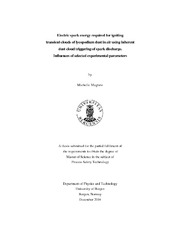| dc.description.abstract | The catastrophic outcome of accidental explosions to humans and property has caused an increased need for new knowledge in order to prevent and mitigate the effects of such events. Amongst other substances, a wide range of gases and dusts can cause such explosions. The present experimental study is concerned with electrostatic- spark-initiation of dust explosions. Lycopodium clavatum was chosen as the test dust, partly because this dust has been widely used in previously published investigations on various aspects of dust explosions. Also, the dust can be obtained throughout the world and research results from various researchers can be compared. In the present study transient experimental clouds of lycopodium clavatum in air were produced by dispersing a given amount of the dust, placed in a small cavity at the bottom of the explosion vessel, by a blast of air. In almost all experiments the nominal dust concentration was stoichiometric. In a few experiments it was twice the stoichiometric. Synchronization of the transient experimental dust cloud and the spark discharge was brought about by the dust cloud itself, when it entered the spark gap that had already been charged to a voltage somewhat below the natural breakdown voltage in just air. This breakdown mechanism may well be one of the mechanisms of dust cloud/spark synchronization that can actually operate in accidental industrial dust explosions initiated by electrostatic spark discharges. One specific problem studied in the present investigation was the influence of the spark discharge duration on the ease by which the dust cloud could be ignited when using the inherent spark discharge triggering method. It was known from the literature that the lowest electric spark energy that can ignite a dust cloud depends strongly on the discharge time of the spark discharge. In the present experiment the discharge duration was varied by varying the series inductance in the discharge circuit. The experimental probabilities of ignition, based on 40-100 apparently identical successive experiments, were presented as functions of the spark discharge duration, electrode shape, spark energy and spark resistance. The influence of air humidity on the natural breakdown voltages of the two different spark gap geometries used was also investigated. The experiments confirmed that the minimum stored capacitor energies required for igniting the dust clouds decreased markedly with increasing spark discharge duration. There was only a modest influence of the spark electrode geometry on the minimum ignition energy (MIE). Experimental correlations between various other parameters were also obtained. The results obtained have thrown light on the influences of some relevant physical parameters on the likelihood of accidental electrostatic spark ignition of dust clouds. However, there is a clear need for more research in this area, and some suggestions for future studies are indicated. | en_US |
